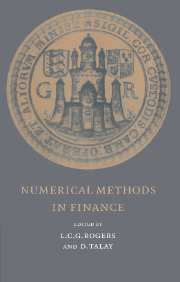Book contents
- Frontmatter
- Contents
- Contributors
- Introduction
- Convergence of Numerical Schemes for Degenerate Parabolic Equations Arising in Finance Theory
- Continuous-Time Monte Carlo Methods and Variance Reduction
- Recent Advances in Numerical Methods for Pricing Derivative Securities
- American Options: A Comparison of Numerical Methods
- Fast, Accurate and Inelegant Valuation of American Options
- Valuation of American Option in a Jump-diffusion Models
- Some Nonlinear Methods for Studying Far-from-the-money Contingent Claims
- Monte Carlo Methods for Stochastic Volatility Models
- Dynamic Optimization for a Mixed Portfolio with Transaction Costs
- Imperfect Markets and Backward Stochastic Differential Equations
- Reflected Backward SDEs and American Options
- Numerical Methods for Backward Stochastic Differential Equations
- Viscosity Solutions and Numerical Schemes for Investment/Consumption Models with Transaction Costs
- Does Volatility Jump or Just Diffuse? A Statistical Approach
- Martingale-Based Hedge Error Control
- The Use of Second-Order Stochastic Dominance To Bound European Call Prices: Theory and Results
Some Nonlinear Methods for Studying Far-from-the-money Contingent Claims
Published online by Cambridge University Press: 05 June 2012
- Frontmatter
- Contents
- Contributors
- Introduction
- Convergence of Numerical Schemes for Degenerate Parabolic Equations Arising in Finance Theory
- Continuous-Time Monte Carlo Methods and Variance Reduction
- Recent Advances in Numerical Methods for Pricing Derivative Securities
- American Options: A Comparison of Numerical Methods
- Fast, Accurate and Inelegant Valuation of American Options
- Valuation of American Option in a Jump-diffusion Models
- Some Nonlinear Methods for Studying Far-from-the-money Contingent Claims
- Monte Carlo Methods for Stochastic Volatility Models
- Dynamic Optimization for a Mixed Portfolio with Transaction Costs
- Imperfect Markets and Backward Stochastic Differential Equations
- Reflected Backward SDEs and American Options
- Numerical Methods for Backward Stochastic Differential Equations
- Viscosity Solutions and Numerical Schemes for Investment/Consumption Models with Transaction Costs
- Does Volatility Jump or Just Diffuse? A Statistical Approach
- Martingale-Based Hedge Error Control
- The Use of Second-Order Stochastic Dominance To Bound European Call Prices: Theory and Results
Summary
Introduction
The purpose of most models is to explain the most commonly occurring phenomena. When designing a model and fitting parameter values, largedeviations situations are ignored, at least to begin with, and the success of the model is judged by the way it can explain common situations. Although models designed in this way will have implications for large deviations, those same large-deviations situations may reveal a richer structure not evident in ‘typical’ behaviour.
We are going to show how, in the framework of diffusion models (the most commonly-used of financial models), one may be led to take as constant quantities whose variable and random characteristics only appear in large motions of the market. We will give a general statement on the information likely to appear in large deviations of the market, and on other latent risks.
This applies naturally to models where volatilities or correlations are supposed constant, even though in reality this is not the case. Our results suggest an explanation of the ‘smile’ of the implied volatility curve (that is, overvaluation of options far from the money). Furthermore, the results display implied volatility smiles as a quite general phenomenon.
This is the reason why we will start by presenting this particular case, which will give an introduction and an intuition to the general results in Section 3.
Finally, in Section 4, we will show how the asymptotic estimations in Section 3 can be used in order to improve numerical calculation methods for out-of-the-money contingent claims.
- Type
- Chapter
- Information
- Numerical Methods in Finance , pp. 115 - 145Publisher: Cambridge University PressPrint publication year: 1997
- 2
- Cited by



